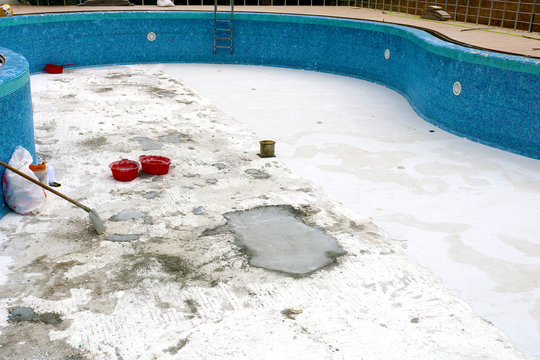Table of Contents
Plaster disintegration is an inevitable reality, but the imminence of which can be delayed by proper care and maintenance. Although it can be resurfaced any time, pool plastering costs an exorbitant amount that might leave your bank empty. It would be somewhat equivalent to reconstructing the whole structure. A plethora of factors that contribute to its decomposition, and by addressing them, we can effectively prolong the pool’s lifespan. As the owner, knowing what damages your backyard oasis and how to eliminate those factors hold paramount importance for you. So, here we have put forth all you need to know about pool plaster care and maintenance.
Pool Plaster Maintenance Guide
First Step After Plaster Renewal
Once the pool plastering is carried out successfully, it all comes down to pool owners to take care of it. Your first and foremost priority should be filling the pool up to its neck (around the skimmer opening). That is because plaster thrives underwater better and when exposed to dry and warm air, cracks can emerge on the surface even if it is newly treated.

Chemical Maintenance
Most of the time, chemical imbalance triggers surface decay, which ends up costing you a fortune. By maintaining a proper chemical equilibrium, you can prevent the plaster from decomposing fast and save yourself from the colossal pool plastering expenditure.
The health of the pool surface is always at the mercy of the water’s pH level. Any fluctuations in the alkalinity could trigger a chain reaction of plaster breakdown, causing scaling, flaking, and cracking of the surface. When the pH drops below the neutral, it erodes not only the surface but also the expensive pool equipment. Whereas if the alkalinity rises, you may witness scales and discoloration of the surface, which looks revolting. As a result, the surface becomes coarse, giving rise to irregular deformities, which is uncomfortable to step on.
To avoid these terrible consequences, all you need is a weekly chemical adjustment. For instance, the water pH should lie between 7.2 to 7.8, which is safe for the swimmers as well as the pool surface. If the pH level is somehow shifted, you can add various chemicals to fix the fluctuations. If it feels way out of your league, you must get help from professional pool plastering services to nip the problem in the bud.
Preventing Metal Stains
Stains come and go, but some persist and even stand their ground against bleaching. There is a high chance that persisting smudges could be metal stains. When the concentration of metals such as iron or copper increases in the water, such signs become prevalent all over the plaster. It isn’t a highly alarming situation and can be easily treated with some simple remedies. Without hiring a pool plastering service, you can trouble-freely get rid of them by rubbing a vitamin c tablet on the smudgy area. Or visit the nearby pool store and purchase chemicals for effective removal.
Regular Filtration
Daily filtration is one of the obvious maintenance tips, but it isn’t as straightforward as you might think. Filters and pumps work side by side to create a continuous gyration, pushing the water through mesh screens, thus removing dirt and debris. If left unattended, these impurities either amass around the surface or within the equipment, clogging the system and halting the filtration process.
When the water is not getting filtered, it becomes a sanctuary for all types of impurities that potentially wreak havoc on the plaster, resulting in discoloration and strains. So, something as simple as regular filtration can help you save the pool surface and ensure longevity.
Removal of Algae Stains
Filter malfunction, abrupt weather changes, and various contaminants create a hosting environment for the algae spores to bloom and take over your swimming pool. Not only will the water turn green as a result, but also the pool surface. You might notice slimy substances present on the surface, which feels gross to step on.
Here, nothing but shock treatment can save your pool’s life. It is about introducing a mammoth amount of chlorine and other chemicals in the water to kill the plants and halt the outspread. It may help you get rid of the greenish water, but the stains might persist even after the shock treatment. Regular cleaning methods are ineffective against them, so you must take another approach — take granular chlorine and pour it over the surface. This way the stains will come off much easier.
Shield the Surface from Sunrays
Leaving the pool uncovered is the biggest mistake any pool owner can do, which can mess up the surface before the next season. What they fail to realize is that direct sunlight contains high-intensity wavelength, long-term exposure of which can prove catastrophic for the plaster. The surface should always be covered, either with water or a shade to cancel out the high-energy radiation.
Even during the active season, keep the pool filled with water. It will prevent the plaster from cracking and flaking off.
DIY Pool Plastering | Filling the Cracks
Treat the cracks before the situation worsens right after their emergence. If ignored, the cracks may grow and become prone to leakage. The easiest pool plastering method is to fill the gaps with calcium carbonate and other compounds to reinforce the compromised areas. You don’t need a professional pool plastering service to pull this off successfully. Just follow the below-mentioned steps:
- Remove the debris from the cracks.
- Use a screwdriver to draw out any remaining loose materials.
- Prepare the pool putty solution as per the instruction manual.
- Fill the gap perfectly so that the cracks aren’t visible anymore.
- Leave the solution be and wait for solidification.
- Just scrape off the additional material for a smoother feel.







